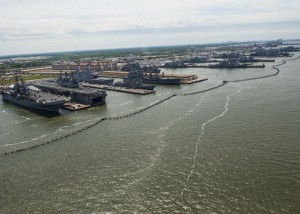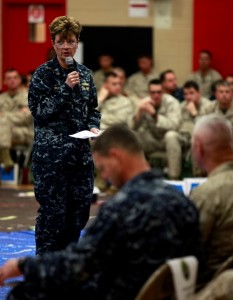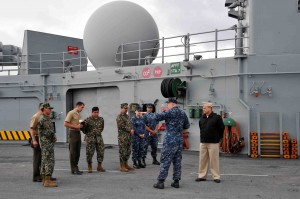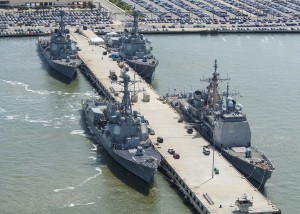2013-05-08 In a wrap-up interview with regard to Bold Alligator 2013, Rear Admiral Phillips, the 2nd ESG Commander, and Brigadier General Love, the 2nd MEB Commander, described the nature and impact of the USN-USMC and Coalition approach to shaping more effective and flexible sea base capabilities.
According to one source: This year’s exercise scenario involved coalition forces working to rid the fictional country of Amber from the invading aggressor country of Garnet. During the scenario participants’ simulated ship-to-shore landings, coordinated continuous air support, and conducted maritime security operations while aggressively fighting their way through the fictional enemy forces on land.
Clearly, one interesting aspect of the effort was starting with a significant anti-access, area denial capability and then working through that challenge to put forces ashore.
The forces ashore were then supported by an expeditionary logistics approach which was designed to provide support targeted for the at shore forces, rather than building a mobile WALMART which would then itself have to be protected.
Rear Admiral Ann Phillips is a Black Shoe or a surface warfare officer. She is currently the Commander of Expeditionary Strike Group TWO in Little Creek, VA and recently moved from the Pentagon where she served on the Chief of Naval Operations Staff as deputy director of Surface Warfare (N86B) and, then, director of Surface Warfare (N86). Not surprisingly, she has significant Aegis experience.
Brigadier General John Love is the Deputy Commanding General, II Marine Expeditionary Force and Commanding General, 2d Marine Expeditionary Brigade at Camp Lejeune, NC. Upon promotion to Brigadier General he served from 2010 to 2012 as the Chief of Staff, Naval Striking and Support Forces NATO in Naples, Italy. During March to August 2011 he participated in NATO’s Operation UNIFIED PROTECTOR, the enforcement of UN Security Council Resolutions in Libya.

SLD: What has been the role of the surface fleet within the Bold Alligator 2013 in support of the ground insertion force?
Rear Admiral Ann Phillips: It actually has a key role. Historically, when one thinks about the traditional role, say in World War II, one focuses upon naval surface fire support and the role of naval guns. But in this day and age, we have a lot more options and alternatives with other weapons, and with our ability to respond, in time, to cyber activities and other challenges.
Today’s surface force has a greater capacity, and we’ll have even more capacity in the future with capabilities like Navy’s Integrated Fire Control – Counter Air to support forces ashore. We can influence the battle space to support the maneuver of Marine forces on the ground with a number of capabilities
For example, when talking about a significant air and missile defense threat, you’ve got to remove that threat. Maritime forces, including Carrier Aviation and long-range TOMAHAWK Strike missiles strategically roll the threat back to gain entry and to gain space for operations.
The Amphibious Task Force with augmented with Cruiser and Destroyers for defense and power projection then provides the support and capability to the ground force to enter the battlespace and then continues that support once forcible entry is achieved.
What we did here over the past several weeks in the Bold Alligator 2013 exercise was to work on combining the capabilities inherent in the Amphibious Task Force with the ground forces to shape a more effective force able to be inserted and withdrawn as needed.
The fleet provides the ground force with support from a close in sea base that’s taking care of Intel, logistics, fire support, Command and Control, and close air support. All of this is managed from the sea base and projected forward in support of maneuver ashore.
In the future, with improved capabilities such as the DDG1000 –which we now are about to ready the field–capabilities will continue to grow.
Also, the Aegis radar over time has improved considerably. It has a much better capability and capacity over land now than it ever has. And radars of the future, such as the new Air and Missile Defense Radar will go even beyond that.

SLD: The Admiral has described the key role, which the surface fleet played in the exercise in both the shaping and support functions. How did the MEB shape its operational approach within the exercise?
Brigadier General John Love: The exercise featured an anti-access and area denial threat which was dealt with primarily by carrier strike groups, but with the assistance of forward-deployed Marine forces.. We placed two of our Marine Expeditionary Units, embarked upon amphibious ships, under the tactical control of the carrier strike groups and they played an important role in rolling back the threat.
Once we moved into the amphibious objective area, we knew the capabilities that were provided by the fleet. We knew what the carriers provided and we knew what the ESG provided. And as a consequence of that, we were able to craft a ground scheme of maneuver that took some calculated risks, knowing the capabilities inherent in the fleet.
We conducted operational maneuver on the sea prior to conducting operational maneuver from the sea. In other words, we used the littorals as maneuver space, which allowed us to pick and choose the time and location of our landing, and also to use littorals as part of the deception plan.
Simultaneous with our landing, we were actually using another amphibious ready group further south as part of our deception plan. We were able to disguise the location of our landing.
When we went ashore, because of the sea base, we did not need to establish a large logistics build-up, and I didn’t need to worry about establishing a mature command and control apparatus ashore. I could rely on all those things coming from the Naval force and from my command post afloat.
This allowed me to be light and agile ashore, and it allowed me to keep my lines of communication very narrow, thereby reducing unnecessary risks.
I was able to reduce the force’s exposure to risk ashore from either violent extremist organization or the conventional threat. And it allowed me to deal as well with an obvious political requirement of not coming in with a heavy force perceived as an occupation force. Politically, it will often be the case that a very light footprint will be required to send a message of non-occupation, and it will also allow the force to withdraw rapidly should situations politically or militarily dictate.
In the Marine Corps, we’ve built our Marine air/ground taskforce specifically so that we can provide our own fire support. And that’s why we have such a balanced aviation element in our MAGTFs. It is also dependent upon ashore based fire support, artillery and capabilities like the HIMARS system.
In this case, we were able to put very little of this capability ashore because we knew we had the Marine aviation assets afloat and that we had two carrier striker groups that could provide that support for us.

SLD: As the afloat force moves from the initial task of providing the shaping function, and supporting the initial insertion of force, a major challenge then becomes managing maritime and air security, notably from the various commercial ships and planes in the battlespace.
How do you handle the maritime domain awareness, maritime and air security part of remaining on station to support forces ashore?
Rear Admiral Ann Phillips: The issue you raise is an important one, which does affect our planning and operational thinking.
The way you manage that is through attentiveness and careful understanding of pattern of life. We have the capacity to put things into categories of traditional paths for shipping, for air, and for local commercial traffic. Then, we look for discrepancies. For example, we know where the air corridors are, so if you’re in a Boeing 737 or American Airlines flight number 632, we know where you’re supposed to be and if you’re not where you are supposed to be.
That’s just one way of breaking this down. And that takes a lot of time and training. From there, it’s just a matter of force protection and remaining alert to changes in those patterns.
In a very limited battle space, such as the case in the Bold Alligator scenario, we had very little time to respond to the asymmetric threat since we were operating so close to the shore. Therefore, we worked diligently to make sure that we were postured, that our weapon systems are postured, and that our people are trained to react through a series of procedures, and preplanned responses, which differ to meet the threat and the operating environment.
Concurrently, we took an offensive posture by employing tactics, techniques, and procedures to project ourselves as hard targets because in those circumstances, extremist organizations and conventional adversaries look for and engage weak targets in an effort to make a statement.
That’s part of the risk that you have to analyze as you’re making your decisions about how you’re going to operate and where you’re going to operate. It is certainly a challenge and it is a greater risk to operate in a confined battle space.
SLD: Could you describe the approach to shifting from being a supported to a supporting command in this situation?
Brigadier General John Love: The Marine expeditionary brigade was the landing force for the operation. And in any amphibious operation, it is the landing force scheme of maneuver ashore upon which the other activity is based in terms of picking the landing locations, determining where you then have to roll back the A2AD (Anti-Access and Area Denial) to allow access to those locations.
From the very beginning, taking the ground scheme of maneuver into account, there was seamless integration across the carrier strike group, the expeditionary strike group and the MEB.
As we closed into the joint operational area, the carrier strike group, as the supported commander in that phase, had the job of rolling back the A2AD as Admiral Phillips said.
And both the ESG and the MEB’s elements played a key role in that with the use of the Marine expeditionary units and amphibious ready groups conducting long-range raids that helped roll back the ground based costal defense systems.
The carrier strike group created the conditions that allowed the expeditionary strike group, to then close into the amphibious objective area, using the littorals as maneuver space.
The expeditionary strike group then delivered the landing force to the shore. And in that phase, the expeditionary strike group was the supported commander.
Once the landing force was ashore and had achieved sufficient combat power and command-and-control capabilities ashore, the landing force became the supported command.
In other words, the objective is to have a seamless shifting of supported/supporting relationships across all three of these major commands.

SLD: How would you describe the importance of having such a highly flexible force to operate in a variety of settings?
Brigadier General John Love: I think the Navy and Marine expeditionary force like this is probably the best suited of all the combinations in the armed forces to arrive on the scene, and be ready to respond to a full range of missions. We can operate literally from the very low end of the range of military operations, all the way up to an enabling force for the high end of military operations.
This allows you to arrive on the scene, conduct an estimate of the situation – all the political factors, all the military factors, the mission, – and then customize the force.
And you can put just the force that is required ashore and then you can build on that force as the situation escalates, or you may choose to conduct distributed operations in in multiple locations from the sea base.
Because we are uniquely well suited for ship-to-shore movement our flexibility is enhanced as well. The MV-22s and the LCACs are especially important tools that enable this flexibility. This allows you to aggregate the force at sea and then disaggregate the force ashore as the situation dictates. And that’s just very unique, I think, to this type of force.
SLD: The logistics part of this is crucial. The approach allows the Commander to reduce the footprint ashore, and to reduce the demand for the provision of force for shore-based logistics. This allows as well the opportunity to rethink how to calibrate force.
Brigadier General John Love: I think it is the ultimate economy of force model in terms of light, small forces. One could start with single ship, a special purpose MAGTF, like we do now with the Africa Partnership Station and conduct Phase 0 activities. You can aggregate onto that force with the Marine expeditionary unit and the amphibious ready group should the situation arise.
And just that presence alone is a crisis deterrent. And if crisis continues to escalate, one can continue to aggregate larger forces. The next larger force would be an ESG and a MEB. Or if the crisis doesn’t escalate, you just dissipate the forces. And you’ve done this without any footprint, without any ground basing.
Rear Admiral Ann Phillips: And you have the ability to tailor it completely. We can configure the force to meet our needs. We can tailor what aspects of the MEU we want on a certain ship and what capabilities we want to bring ashore. From the seabase, we provide medical support, combat systems support, logistics, ISR, and command-and-control. We can scale it up or scale it down.
It’s highly flexible, it’s reconfigurable, it can go anywhere. We can achieve the objective and then move on, leaving no footprints ashore.
Brigadier General John Love: There was a recent situation where one of the combatant commanders requested a Marine Special Purpose MAGTF for a crisis response. And the secretary of defense approved it, pending host nation approval for basing, even though it’s temporary. And it took six weeks to acquire the host nation approval for us to base.
If that’s what we want to be dependent upon to satisfy our combatant commanders requirements for a hastily deployable crisis response force, we should probably reconsider. It sure would be nice if that force was able to just deploy in international waters without the requirement for host nation approval.
SLD: Bold Alligator, this year and last year has demonstrated a flexibility the Navy and Marine Corps is now practicing to influence events ashore but with flexible means. Could you talk more about the importance of the inherent flexibility you’ve demonstrated?
Rear Admiral Ann Phillips: The real advantage is having a scalable capability — a force that you can maneuver as you need to, based on the situation that you’re dealing with. You have an opportunity to work independently as an ARG/MEU, or as an ESG/MEB. This ability allows us to appropriately respond to put the enemy in an uncomfortable position.
We’ve also been able to demonstrate that we can operate from the sea in a sea-basing capacity where forces ashore are able to maneuver with support from the sea-based amphibious architecture that allows a smaller footprint ashore, greater ability to maneuver, and greater flexibility with the support being provided directly from ships.
As we’ve discussed, we can support offshore with Marine Aviation, with fires, with intelligence, with command-and-control, and with ISR.
We’ve been able to demonstrate a number of different capabilities and considerable flexibility with this infrastructure. In this case, using forces up to and including a full MEB, and we have also operated a large number of amphibs using their unique abilities to influence battle space, at sea and in the air to support maneuver forces ashore.
As a part of the Bold Alligator 2013 scenario this year, we had an opportunity to really demonstrate the full range of amphibious capabilities in a medium threat environment from initial entry and anti-access and area denial rollback, with the carrier strike group in the lead as well as the supported commander, to reduce or roll back the threat to allow the ARG/MEU to enter and then to allow the amphibious task force to enter.
In addition, we were successful in using the ARG/MEU team in a different venue — providing a distraction through an amphibious demonstration, which gave the enemy pause and confused their picture a little bit. We were able to land forces ashore as well as conduct a simultaneous demonstration because of our unique ability to place naval forces in different locations and still influence what’s going on ashore.
SLD: General, could you provide a final comment on how to view an ESG-enabled MEB force from the perspective of this exercise?
Brigadier General John Love: Once ashore, the landing force was able to conduct maneuver ashore fully supported from the sea. When I developed my concept of operations, I took a lot of matters into account. I included the mission, as well as the troops and fire support available in our planning process. I knew that I could rely on the Navy, from the sea base, to provide support in the form of logistics, command-and-control, fires, and intelligence.
Consequently, I was able to establish a lighter footprint, I was able to be more maneuverable, and I was able to comply with some of the host nation and political considerations. I would not appear as an invading force.
The result was my ability to then maneuver and accomplish the mission ashore with much more ease than had I been required to develop a heavier footprint.
And so, the way I see it was that the operation wasn’t just a lodgment, it was a sustained operation. And five days into the operation, I’m still very light, I have just the minimum amount of logistics ashore that I need for two or three days of operations because I know that I can depend on the continued sea base to provide that type of support.
I think the flexibility is phenomenal. I have still have an operational reserve on the sea base so that I can insert that force, supported by the ESG, at any other location inside the amphibious operational area to either compliment my main effort, to distract, to be a supporting effort, or should some other crisis arise in the AOA, I can respond appropriately.
That’s the flexibility you get from a sea base and that’s the flexibility you get from the support to the landing force by both the expeditionary strike group and the carrier strike group.
For our report on Bold Alligator 2012 go the following:

